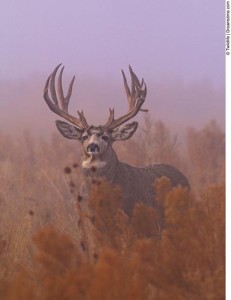Modern Mule Deer: Big Buck Classification
I have categorized mature mule deer bucks into three categories: trophy bucks, superbucks, and megabucks.
Trophy bucks are mature, solid 4-point or better bucks, four years or older, and sporting a rack above 160 inches. Trophy bucks are still common these days, but dwindling in numbers each year.
Superbucks are older and bigger bucks in their prime, aged around 6-10 years. They have very large and wide antlers scoring 200 inches or more. These bucks are extremely rare, often referred to as ‘once-in-a-lifetime’ bucks. Many hunters will never see a superbuck in the wild.
Megabucks are very old bucks scoring close to 300 inches, have mass like a baseball bat and towering racks that resemble elk. When I was younger I referred to these as ‘elk-deer’ because at first glance, your mind can’t classify it as a deer. The key ingredient to Megabucks is age. Megabucks are more common in warmer climates where they live longer (12-13 years instead of 10). I’ve been hunting a long time—25 years to be exact—and I’ve only seen three bucks that you might call megadeer. All three megabucks were in the Central Utah Manti-Lasal Range. I spotted the first one in 1996, the second in 2001, and the last megadeer I ever saw was in 2002. After 2002 I spent more days afield, but never saw another megadeer.
Superbucks are the hunter’s last hope. With a finite amount of wild lands and ever-increasing human population encroaching on winter range and over-development of every square inch of land, bucks can no longer live long enough to reach mega proportions. Fortunately, we still have a few superbucks around—I see one or two every year. The problem is not with ‘trophy hunters’ shooting all the big ones, but with non-trophy-hunters, or meat-hunters, blowing away all the spikes and forked-horns every year. One and two years old bucks don’t have enough experience in the wild to reach maturity, which is why they’re such easy targets. But the few babies that do slip through the cracks have the potential of reaching magnificent proportions. These are the only bucks that I—and other trophy hunters–hunt anymore: the elusive surviving few.
According to biologists, if a mule deer buck survives to be 5 years old, it has an 80% chance of dying of old age or other natural causes. Every year that a buck survives, it gets exponentially smarter. The problem is that 80% of yearling bucks never make it to five years old. One thing that trophy-seekers should keep in mind is that Superbucks don’t just father more super-bucks, but super-does as well. These superdoes pass along and teach their offspring the super-instincts that allowed Grandfather Superbuck to survive for so long. Over time, this results in an ever-wizening herd. Breeding is only done by the biggest and smartest bucks. So each successive generation of deer— doe or buck—is the spawn of super-intelligent bucks. Often times, when you observe a doe in the wild it seems kinda dumb (compared to the bucks). But this is only because no one is hunting her. If the doe were hunted, it would wizen up fast, I guarantee it!

